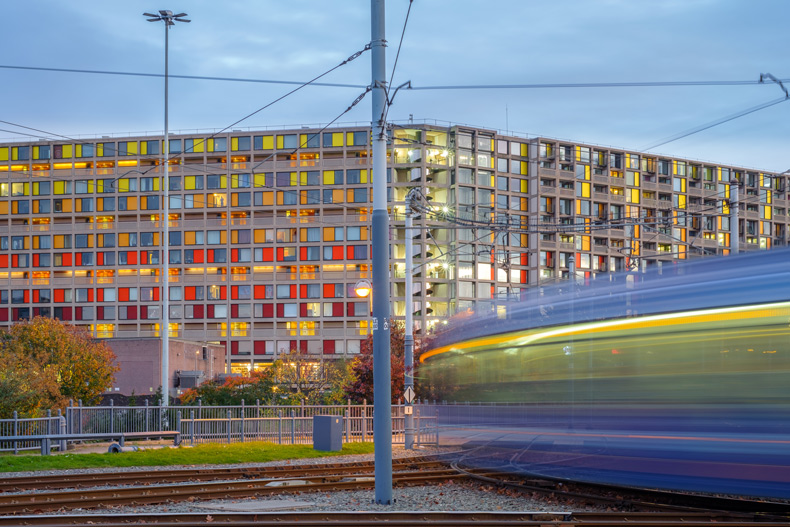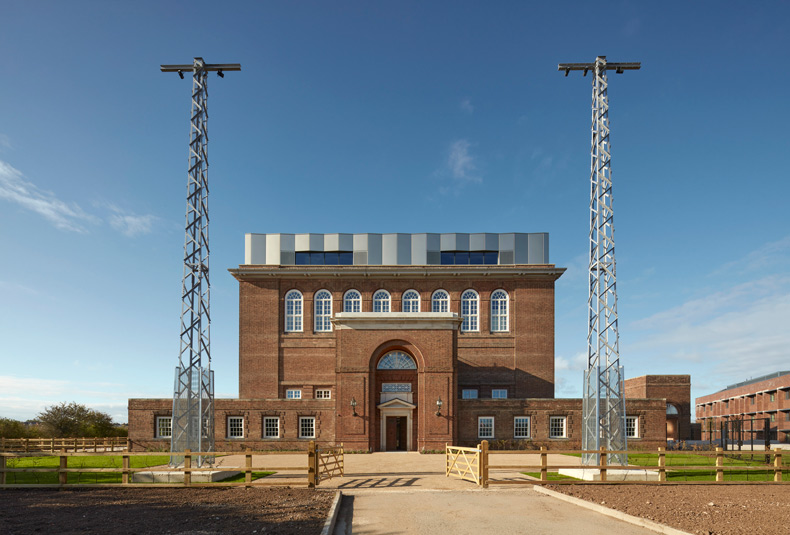With the launch of the Royal Institute of British Architects’ new Reinvention Award and the recent reprieve from the wrecking ball for the art deco Marks & Spencer building on London’s Oxford Street, you may be forgiven for thinking that retaining the old is in vogue. Yet when it comes to post-war buildings, which make up the vast majority of our built environment, the default response of developers and planners is still to knock them down and start again – despite the attendant carbon emissions. The push to ‘regenerate’ brownfield sites is generally a euphemism for demolishing structures that are perceived to be past their sell-by date, despite being younger – and in many respects more adaptable – than the older buildings that traditionalists are so keen to see preserved.
While Georgian, Victorian and Edwardian buildings do have advantages of relative flexibility in some respects, they can be wholly unsuited to adaptation in others. Most have little structural capacity for upwards extension; their foundations are usually dubious to non-existent; dry rot and woodworm have often eaten away at their fabric; room sizes are limited. Newer buildings can, of course, come with problems too: built-in plumbing, wiring and ventilation that are the first things to fail; low floor-to-ceiling heights in some cases; the presence of asbestos; concrete failure. Nevertheless, most are built to far sturdier standards, and to more flexible grids, than their forebears. It is clear that such buildings can be successfully brought back into use: not just the amazing ones, like Sheffield’s Park Hill (now so popular that the National Theatre made a musical about it) but also the ugly ducklings. These include Ty Pawb, a mundane multistorey carpark in Wrexham that is now a flourishing market, community centre and arts hub, or the monolithic concrete Royal Mail sorting office-turned-secondary school in Northampton.

Park Hill housing estate in Sheffield, built in 1957–61, is undergoing continuing renovations by developers Urban Splash. Photo: Felix Mooneeram; courtesy Urban Splash
Working with existing buildings is undoubtedly more difficult, and often more expensive, than building from scratch. It is complex, requires real design imagination and actual technical skills, so is unsuited to the detail-lite process of design-build, the preferred procurement approach of lazy project managers. It was a botched, cut-price attempt to upgrade an existing building using flammable materials that led to the horror of the Grenfell Tower fire, but this was not an inevitable consequence of retrofitting. The work of French architects Lacaton & Vassal, among others, shows how it is possible to reclad tower blocks in a way that makes them more beautiful, more functional, more fire-safe and less energy-intensive. If the legacy of Grenfell is to stop the improvement of post-war social housing in its tracks and to tear down and rebuild instead, the wrong lessons will have been learnt.
The shortlist for the RIBA’s new Reinvention award shows that, when clients employ teams with the right skills and don’t try to cut corners, we can restore, repurpose and reinvigorate all manner of buildings for present and future needs. But the current system is a contradictory mess of rules. Cheap and shoddy conversions of non-listed buildings fly under the radar due to ‘permitted development’ rules that actively dissuade developers from improving the appearance of the buildings they convert in this way. Householders who wish to improve the energy efficiency of older homes face a bewildering array of barriers and are frequently knocked back on heritage grounds. And politicians and think tanks decry the architectural ‘mistakes of the recent past’ and declare a crusade against anything made of concrete, deemed ‘modern’ or, worse still, ‘brutalist’ – one commentator even going so far as to call for a ‘Demolition Commission’ to rid the country of these apparent eyesores – while simultaneously bending over backwards to preserve the buildings that conform to their narrow definition of beauty.

Houlton School, converted from what was Rugby Radio Station by van Heyningen and Haward Architects, is a finalist for the RIBA Reinvention Award. Photo: James Brittain; courtesy RIBA
If we are serious about reducing the carbon impact of construction, then no matter how ungainly the building (let’s say a 1980s out-of-town Tesco, though even those have fans in obscure corners of the internet), it should be retained and repurposed if the carbon sums show a saving. Those of us with a fondness for Cedric Price can happily daydream about the architectural collisions and juxtapositions that could result from the adaptation of these monoliths. The reinvention of a few post-war listed buildings shows how this can be achieved – a personal favourite is the reuse of an early Norman Foster warehouse as a soft-play centre.
Buildings – whatever their aesthetics – should not be single-use, disposable items to be crushed into landfill at the end of their first generation. When it is more difficult to install double glazing and insulation into an average Victorian terraced house than it is to knock down the entirety of Cumbernauld town centre, something has gone very wrong with our planning system. We should all stand up for saving more ‘unpopular’ buildings – even ones we personally dislike – and encourage reinvention and renewal rather than the wrecking ball.
Hana Loftus is a designer, planner and policy-maker. She is a director of HAT Projects, an architecture and planning practice.

Demolishing post-war buildings shouldn’t be the default
The Renault Distribution Centre, built in 1982 by Foster Associates (now Foster + Partners), has now been repurposed as a soft play centre. Photo: Richard Davies
Share
With the launch of the Royal Institute of British Architects’ new Reinvention Award and the recent reprieve from the wrecking ball for the art deco Marks & Spencer building on London’s Oxford Street, you may be forgiven for thinking that retaining the old is in vogue. Yet when it comes to post-war buildings, which make up the vast majority of our built environment, the default response of developers and planners is still to knock them down and start again – despite the attendant carbon emissions. The push to ‘regenerate’ brownfield sites is generally a euphemism for demolishing structures that are perceived to be past their sell-by date, despite being younger – and in many respects more adaptable – than the older buildings that traditionalists are so keen to see preserved.
While Georgian, Victorian and Edwardian buildings do have advantages of relative flexibility in some respects, they can be wholly unsuited to adaptation in others. Most have little structural capacity for upwards extension; their foundations are usually dubious to non-existent; dry rot and woodworm have often eaten away at their fabric; room sizes are limited. Newer buildings can, of course, come with problems too: built-in plumbing, wiring and ventilation that are the first things to fail; low floor-to-ceiling heights in some cases; the presence of asbestos; concrete failure. Nevertheless, most are built to far sturdier standards, and to more flexible grids, than their forebears. It is clear that such buildings can be successfully brought back into use: not just the amazing ones, like Sheffield’s Park Hill (now so popular that the National Theatre made a musical about it) but also the ugly ducklings. These include Ty Pawb, a mundane multistorey carpark in Wrexham that is now a flourishing market, community centre and arts hub, or the monolithic concrete Royal Mail sorting office-turned-secondary school in Northampton.
Park Hill housing estate in Sheffield, built in 1957–61, is undergoing continuing renovations by developers Urban Splash. Photo: Felix Mooneeram; courtesy Urban Splash
Working with existing buildings is undoubtedly more difficult, and often more expensive, than building from scratch. It is complex, requires real design imagination and actual technical skills, so is unsuited to the detail-lite process of design-build, the preferred procurement approach of lazy project managers. It was a botched, cut-price attempt to upgrade an existing building using flammable materials that led to the horror of the Grenfell Tower fire, but this was not an inevitable consequence of retrofitting. The work of French architects Lacaton & Vassal, among others, shows how it is possible to reclad tower blocks in a way that makes them more beautiful, more functional, more fire-safe and less energy-intensive. If the legacy of Grenfell is to stop the improvement of post-war social housing in its tracks and to tear down and rebuild instead, the wrong lessons will have been learnt.
The shortlist for the RIBA’s new Reinvention award shows that, when clients employ teams with the right skills and don’t try to cut corners, we can restore, repurpose and reinvigorate all manner of buildings for present and future needs. But the current system is a contradictory mess of rules. Cheap and shoddy conversions of non-listed buildings fly under the radar due to ‘permitted development’ rules that actively dissuade developers from improving the appearance of the buildings they convert in this way. Householders who wish to improve the energy efficiency of older homes face a bewildering array of barriers and are frequently knocked back on heritage grounds. And politicians and think tanks decry the architectural ‘mistakes of the recent past’ and declare a crusade against anything made of concrete, deemed ‘modern’ or, worse still, ‘brutalist’ – one commentator even going so far as to call for a ‘Demolition Commission’ to rid the country of these apparent eyesores – while simultaneously bending over backwards to preserve the buildings that conform to their narrow definition of beauty.
Houlton School, converted from what was Rugby Radio Station by van Heyningen and Haward Architects, is a finalist for the RIBA Reinvention Award. Photo: James Brittain; courtesy RIBA
If we are serious about reducing the carbon impact of construction, then no matter how ungainly the building (let’s say a 1980s out-of-town Tesco, though even those have fans in obscure corners of the internet), it should be retained and repurposed if the carbon sums show a saving. Those of us with a fondness for Cedric Price can happily daydream about the architectural collisions and juxtapositions that could result from the adaptation of these monoliths. The reinvention of a few post-war listed buildings shows how this can be achieved – a personal favourite is the reuse of an early Norman Foster warehouse as a soft-play centre.
Buildings – whatever their aesthetics – should not be single-use, disposable items to be crushed into landfill at the end of their first generation. When it is more difficult to install double glazing and insulation into an average Victorian terraced house than it is to knock down the entirety of Cumbernauld town centre, something has gone very wrong with our planning system. We should all stand up for saving more ‘unpopular’ buildings – even ones we personally dislike – and encourage reinvention and renewal rather than the wrecking ball.
Hana Loftus is a designer, planner and policy-maker. She is a director of HAT Projects, an architecture and planning practice.
Unlimited access from just $16 every 3 months
Subscribe to get unlimited and exclusive access to the top art stories, interviews and exhibition reviews.
Share
Recommended for you
The true test of a building is the passing of time
At RIBA a film by Jim Stephenson shows that architecture can have a long and unpredictable afterlife
Shutting up shop: an elegy for the department store dream
These vast, bustling buildings were once emblems of city life – but they’ve been in decline for years and the pandemic has only hastened their demise
Is the system for protecting historic buildings working?
The procedures for protecting England’s historic buildings are now 70 years old. Is the system still fit for purpose?